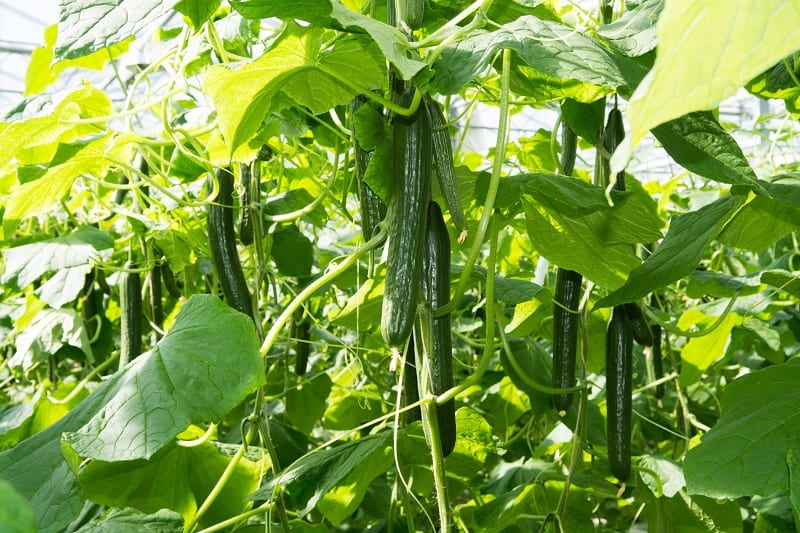
If you notice your cucumber leaves turning yellow, there is something wrong with the plant and you need to identify the problem to know how to properly address it. These problems can range from mild to severe, and you should know how to distinguish between them so that you know what actions to take to save the plant. The causes of cucumber leaves turning yellow include nitrogen deficiency, disease, pests, overwatering, the wrong soil, and insufficient sunlight.
If your cucumber plant’s leaves are turning yellow and you want to learn about how to remedy it, keep reading.
Why are my cucumber leaves turning yellow?
Nitrogen deficiency
The leaves on your cucumber plant will turn yellow if it does not have enough nitrogen. You can treat this by giving your plant a fertilizer rich in nitrogen. You can also add a tablespoon of ammonium nitrate to the soil every three weeks if you see that the plant’s flowers have begun to bloom. Make sure you do not overdose your plant with fertilizer because this can damage the plant and its ability to produce fruit.
Disease
Cucumber plants are susceptible to various bacterial and fungal diseases such as verticillium wilt and mosaic virus. For now, there are no known treatments for these two diseases, so any affected cucumber plant will die. The best thing you can do when faced with these infections is to make sure you remove them and take them as far as possible from your healthy plants. Make sure you destroy the infected plants by burning them to make sure they do not infect anything else.
To better your chances of eradicating these pathogens, make sure you do not plant cucumbers or any other plants of the same family in that same plot of land. Some of these pathogens only thrive in the presence of a specific type of plant, so if they have no possible host, they will have no choice but to die off. This is why rotating crops in your garden is very beneficial.
Pests
There are many types of insects and pests that feed on cucumber plants and can cause the leaves to turn yellow. These include aphids, whiteflies, and spider mites. They feed on the sap of your cucumber plant and will leave the plant to die.
Cucumber plants can tolerate pests for a certain amount of time, but if the pests persist and the infestation grows larger, the plant will eventually succumb.
You can get rid of these pests by using insecticide. Treat the leaves of the plant on a weekly basis or according to the manufacturer’s instructions. Try to only apply the insecticide during the afternoon or early morning, because the heat from the sun may cause the treated leaves to burn.
Another pest that affects cucumbers is the potato leafhopper. They also feed on the sap of the cucumber plant, but they carry a toxin that turns the leaves yellow. These leaves will then drop off until the plant dies.
Another option, if you prefer not to use insecticides, is to use other insects such as pirate bugs, lacewings or ladybugs. These insects do not harm the cucumber plant but do feed on the plant’s pests.
Overwatering
Cucumber plants only need one to two inches of water a week. They can be easily overwatered, just like other plants. If they are overwatered, the roots become deprived of oxygen which can cause the leaves of the plant to turn yellow and wilt. Overwatering, poorly-draining soil, and a pot without drainage holes all contribute to this problem. You can try to loosen the soil or transfer the plant to raised gardening boxes.
Underwatering
Even though cucumber plants do not need that much water, it does not mean that you can just forget to water them for long periods of time. If a cucumber plant does not get the amount of water that it needs, the leaves will turn yellow and wilt. The best way to know if a plant needs watering is to touch the soil in the pot. If it is dry, water the plant, but if it is still damp, you need to wait a day or two before checking the soil again.
Remember that if the weather is warm you need to water the plant more frequently, and if the weather is rainy or cold, lengthen the time between watering a little.
Problems with the soil
Cucumber plants consume a lot of nutrients from their soil. If they do not get their required nitrogen and potassium, their leaves will turn yellow. Cucumber plants need these nutrients to encourage growth and to make sure their new leaves grow out healthy and vibrant. Making sure there is always a nitrogen-rich component in the soil can keep the yellowing at bay. Nitrogen-rich components include coffee grounds, compost and some fertilizers.
If the leaves’ yellow hue is deeper and bronzier, the plant may lack phosphorus. You need to correct this with phosphorus-rich fertilizer before it starts to affect the fruit production.
Not enough sunlight
If your cucumber plant is not getting enough sunlight, the leaves will become yellow and droopy. This is easy to remedy; just transfer the plant to a spot where it can get six hours of sunlight per day.
Conclusion
Yellowing leaves on a cucumber plant are indicative of a problem that should be addressed and resolved immediately.
This change in leaf color can be caused by nitrogen deficiency, disease, pests, over- or underwatering, the wrong soil, or insufficient sunlight.
It is important that you remedy the problem with your cucumber plant as soon as possible, because if you are not careful, this can affect the fruit production not only of one plant, but possibly of all of your cucumber plants.
Image: istockphoto.com / barmalini